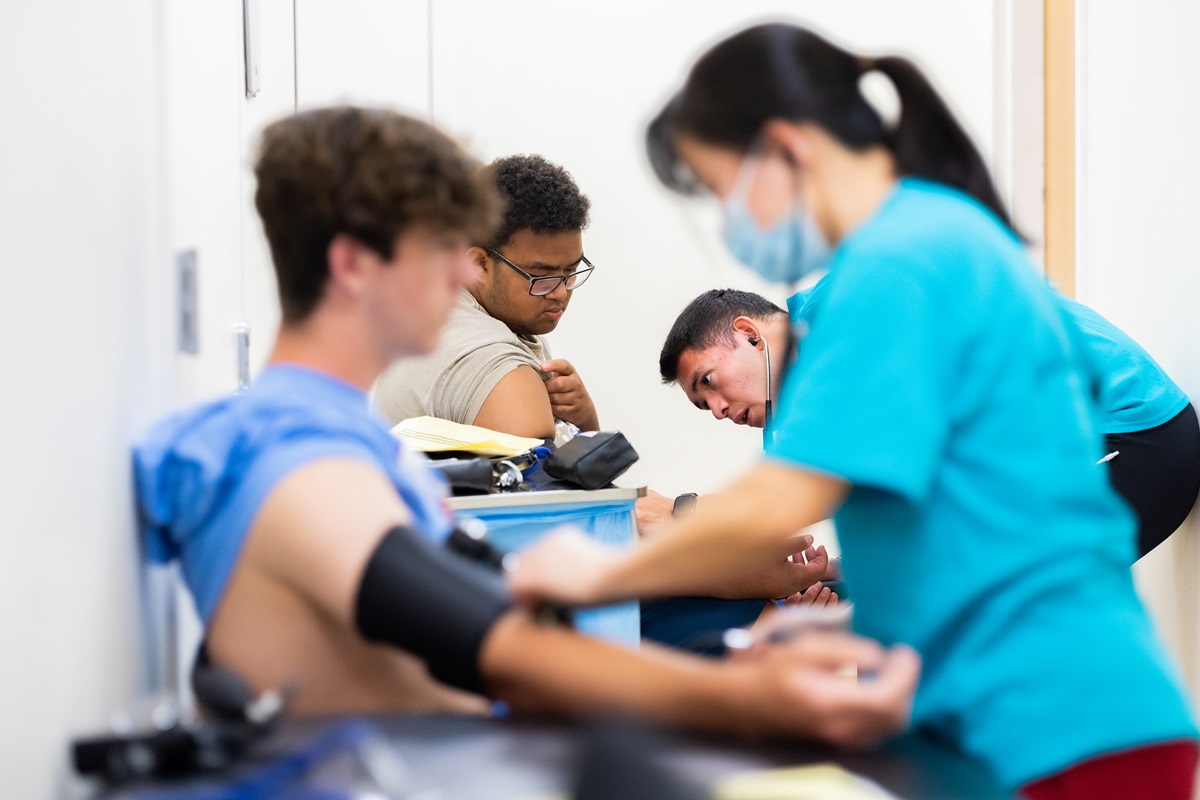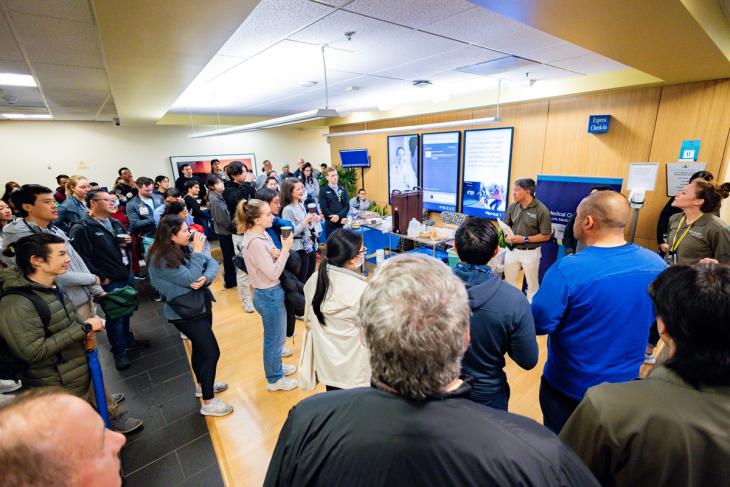With over 5,000 student-athletes, the program ensures the safety and well-being of Bay Area youth through free physicals and cardiac screenings.
The UCSF PlaySafe Sports Medicine Program has served student-athletes in San Francisco and the Bay Area for more than 20 years. The mission of the UCSF PlaySafe Sports Medicine Program is to provide a safe and positive environment for athletic pursuits, facilitate access to the highest quality sports medicine care, and encourage physical and mental growth by empowering student-athletes to lead balanced, physically active lifestyles. PlaySafe strives to bring a comprehensive sports medicine approach to every active community within the Bay Area and be the gold standard of high school outreach programs.
PlaySafe provides free sports physicals with cardiac screening every spring for high school student-athletes. This comprehensive exam can find underlying medical and orthopedic abnormalities and can even help prevent sudden cardiac death. Known as UCSF PlaySafe Cardiac Physicals, this program, the leadership team, and the more than 500 volunteers have impacted the lives of at least 5,000 student-athletes in our community.
PlaySafe is led by Celina de Borja, MD, assistant professor in the Division of Pediatric Orthopaedics; Anthony Luke, MD, MPH, the Lynne and Marc R. Benioff Distinguished Professor of Sports Medicine; and Gina Biviano, MA, ATC, manager of athletic trainers and the PlaySafe Program . Below, the leadership team discusses the impact that PlaySafe and UCSF have on the community and the program’s vision for the ensuring that Bay Area student-athletes have access to the best medical care possible.
What are PlaySafe Cardiac Physicals, and why are these exams important for young athletes?
Gina Biviano: The annual PlaySafe Cardiac Physical event is a collaboration between UCSF Sports Medicine, the PlaySafe Program, and the Division of Cardiology. Every high school student-athlete in California has to have a pre-participation physical evaluation (PPE) annually in order to play sports. The PPE is designed to screen for injuries, illnesses, or other factors that increase an athlete’s risk for injury or illness resulting from their participation in sports. Student-athletes usually receive their athletic PPE at the time of their annual well-child visit with their pediatrician. These evaluations, however, do not have to include a thorough cardiac exam with EKG. The PlaySafe Program believes that including an EKG offers an additional layer of screening to try to identify unknown cardiac issues that can lead to sudden cardiac death (SCD). This is important because SCD is the leading cause of exercise-related death in young athletes.
We started this event in 2009 with the hope that we could save lives, and this hope continues to guide us today. In addition to the identification of risk factors for SCD, we also work to promote healthy behaviors at our event by screening for mental health issues, educating athletes on appropriate sports nutrition and hydration, and providing individualized guidance on injury prevention based on the physician’s evaluation.

How many athletes and volunteers participated this year, and how did this year’s event compare to previous years?
GB: In order to host this event, we have to recruit a very large team of volunteers and also have significant industry support. This year we had 170 volunteers – physicians, surgeons, other health care workers, nursing and medical students, residents and fellows, and community members with no medical background – all working together to provide 380 athletes with a free PPE. We usually average 350-500 athletes and 100-180 volunteers yearly.
This event is not possible without our partnership with GE HealthCare and Philips Healthcare. Every year these companies graciously donate the EKG machines and echo ultrasound machines necessary for our cardiology team to do the heart screens. We also have a long history partnering with the National Football Foundation Northern California Chapter, which helps financially and sends a strong team of volunteers to the event.
Are these exams free for all young athletes in the Bay Area? Do the athletes need to have health insurance to participate?
GB: The PlaySafe Program has served as a model for hospital-based outreach programs for the past two decades. In that time, we have added many schools to our partnership list. As long as student-athletes attend one of these schools, their exams are free regardless of insurance status. This list of our schools can be found on our website. If a school is not currently one of our partners but would like to join us, they can email playsafe@ucsf.edu
There have been several cases in recent years of high-profile collegiate athletes having underlying heart conditions that kept them out of competition and even forced them to stop competing. What can athletes and families do to be more proactive in identifying these dangerous cardiac abnormalities?
GB: Public awareness is key! Educating parents, athletes, and coaches on the recognition of the signs and symptoms of cardiac arrest is really important to preventing SCD. Having automated external defibrillators (AEDs) and staff members trained in CPR and first aid on-site can make a lifesaving difference. Research indicates that schools that hire athletic trainers are more likely to have AEDs, emergency action plans, and other such measures in place. This is why outreach programs with athletic trainers are so important in promoting youth safety!
How does PlaySafe make an impact in the community?
GB: The PlaySafe Program provides team physician oversight and athletic training services at our partner schools throughout the school year. We believe every athlete should have access to high-quality health care with athletic training services. It is well documented that schools with a certified athletic trainer are more likely to follow youth sport safety guidelines, identify and appropriately treat concussions, have an emergency action plan and AEDs on-site, and when athletes do get hurt, assistance to help them successfully navigate the complicated health care system.
We pride ourselves on providing student-athletes with the best evidence-based care and keeping our schools in compliance with state laws and youth safety recommendations. The PlaySafe Program has a medical doctor and an athletic trainer on the California Interscholastic Federation State Sports Medicine Advisory Committee, and multiple athletic trainers serving on the California Athletic Trainers’ Association Secondary School Committee. It is through these leadership roles that we stay up to date and participate in setting state policy to make sports safer in California overall. As technology advancements move our field forward, we aim to bring those resources to the student-athletes we serve. We are uniquely positioned to do exactly that and are adding additional tools and expanding the use of existing technology in the field for our athletic trainers and team physicians.
Dr. de Borja: Our efforts enable youth from low socioeconomic backgrounds to engage in sports, significantly enhancing their physical health and psychosocial wellness. By providing sideline medical coverage, we are also safeguarding the health and safety of student athletes during sporting events. Our presence in the schools may also serve as an inspiration to some students who may not have considered professions in healthcare prior to meeting our athletic trainers and physicians.
Who are the primary members of the PlaySafe team, and what is each person’s expertise and contribution?
GB: In order to provide this event annually in May, the PlaySafe Cardiac Planning Committee starts preparation in January. The team includes me and three other athletic trainers:
- Elise Hammond, ATC, coordinator of UCSF’s Sports Concussion Program, who has been with PlaySafe for 16 years.
- Hally Solarczyk, MA, ATC, assistant to the clinic coordinator in the Sports Concussion Program, who has been with PlaySafe for seven years.
- Katie Wallen, MA, ATC, an athletic trainer in the UCSF Division of Sports Medicine, who’s been with the program for six years.
Along with the athletic trainers:
- Byron Lee, MD, is a cardiologist, director of the Electrophysiology Laboratories and Clinics at UCSF and is crucial to building the team of volunteers necessary for the cardiology station at our event.
- Dr. Luke, MD, MPH, and Dr. de Borja, our PlaySafe medical directors, are UCSF primary care sports medicine providers and help coordinate all aspects of the event including recruitment of medical volunteers and development of the event policy and procedures.
How do you hope to see PlaySafe grow over the next five years?
GB: We hope PlaySafe can serve as a model for outreach programs to provide more high schools with access to athletic training services. We want to be known for providing quality health care to our community and as a hub of education. We launched our first clinical preceptor program for Master’s in Athletic Training students to prepare the next generation of athletic trainers, and we hope interest in this aspect of our program continues to grow.
CDB: We aim to expand our clinical team as we establish new relationships with other high schools throughout the bay area. In addition to growth in clinical impact, adding to the wealth of knowledge in our region remains a top priority. We are eager to dig into topics like injury prevention with coaches and trainers at all levels so all the athletes in the community can compete safely and at a high level. We are motivated to partner with the UCSF Women’s Sports Medicine Center to emphasize the importance of specialized care for female athletes. And finally, we hope to serve as a consultant for youth sports clubs in the community, moving further upstream in the development of athletes, to ensure safe sports policies are implemented. We are excited to foster a vibrant, healthy, athletic community at all levels across the region.
Learn more about the UCSF PlaySafe program here.
